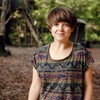These issues are not exclusive to the Middle East. One of Habjouqa's learning curves came when she was working for an alternative paper in Texas, covering an assignment about the local black community. "[They] had fallen out of the tax brackets of surrounding municipalities and were living in shocking poverty," she explains. "Some had no running water. In 2000."But it was about how to go beyond the 'shocking poverty' and tell the story anew with urgency but dignity."Read more: The Young Women Standing Up to Extremism in the Middle East
Shams, an English literature student and member of the university's students union, poses for a picture in Tunis, near the interior ministry where many protests took place in the past. © Laura Boushnak, I Read I Write
Trashtails: a metaphoric portrait of contemporary Egypt. © Myriam Abdelaziz, Trashtails
Egyptian belly dancers are an endangered species, on the road to extinction. That is, if there isn't a belly dance renaissance in Egypt sometime soon. © Myriam Abdelaziz, Cairo Dances
"I think we see it as an honor when any one of us asks another's opinion. And, beyond just friendship, I have a deep respect for the work that my colleagues produce. In countless lectures and teaching opportunities, I refer to their work when covering critical gender, social, and political issues."Read more: The Illegal, Underground Ballerinas of Iran
Bader, Kuwaiti. Started in 2009, this portrait series is part of a large body of work capturing semi-nude Arab men of diverse backgrounds. © Tamara Abdul Hadi, Picture an Arab Man
Shams (left), who won the Student Union elections at her university, sits with her colleagues at her favorite spot, which is graffitied with an image of Lebanese thinker Mahdi Amel. © Laura Boushnak, I Read I Write
Wadi As-Salam ("Valley of Peace), is a cemetery located in Najaf, a province in the Western part of Central Iraq. This vast cemetery (over 5 million people are buried here) is considered to be the second largest and oldest cemetery in the world. © Tamara Abdul Hadi, Valley of Peace
West Bank: Portrait of a young man. After grueling traffic at the Qalandia check point, a young man enjoys a cigarette in his car as traffic finally clears on the last evening of Ramadan. © Tanya Habjouqa, Occupied Pleasures
